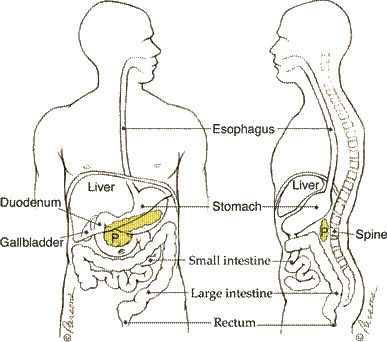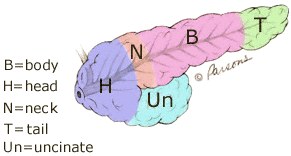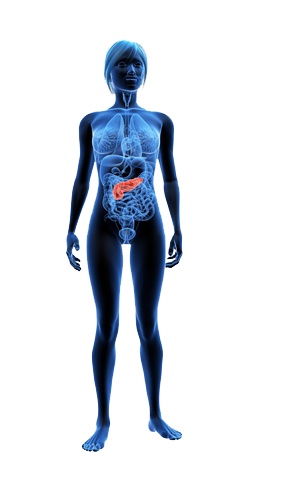Pancreatic Cancer
For Patients
Pancreatic cancer is relatively uncommon, accounting for only 2.5% of all cancer cases in Australia. Therefore, some people may not fully understand the role of the pancreas and how cancer can develop here. This section outlines the functions of the pancreas, as well as important information about pancreatic cancer, including possible causes, diagnosis and treatment.
The Pancreas
What is the pancreas?
The pancreas is a 15-25 cm (6-10 inches) flattened and oblong-shaped gland. It is located in the abdomen between the stomach and the spine. It has 2 main functions: (1) to produce many important hormones such as glucagon and insulin, and (2) to secrete enzymes, water and other substances in order to digest food and absorb nutrients.
What does the pancreas look like?
The pancreas is divided into 5 main regions
Uncinate process – The area of the pancreas that bends backwards and beneath the body of the pancreas. The uncinate process is where 2 crucial blood vessels (the superior mesenteric artery and the superior mesenteric vein) intersect.
Head – The head is the widest portion of the pancreas. It is located on the right side of the abdomen and is joined to the duodenum (part of the small intestine).
Neck – The neck is the thin region between the head and body of the pancreas.
Body – The body is the middle section of the pancreas between the neck and the tail. The superior mesenteric blood vessels are located behind the body.
Tail – The thin tip of the pancreas is called the tail. It extends towards the spleen.


The pancreas is made up of glandular tissue and ducts (passages or tubes for substances to flow through). The main pancreatic duct (duct of Wirsung) drains pancreatic fluid from the pancreas into the duodenum. There are many small ducts branching from the main pancreatic duct. The main pancreatic duct joins the bile duct to form the ampulla of Vater. The ampulla of Vater is a wider duct that opens into the duodenum. Many individuals also have a small accessory duct (duct of Santorini) which extends from the main duct to the duodenum.
What does the pancreas do?
The dual function of the pancreas is reflected in the 2 types of cells it is comprised of:
- Endocrine cells (Islets of Langerhans): These cells are responsible for the production and secretion of many important hormones into the bloodstream. The main pancreatic hormones insulin and glucagon work together to regulate blood sugar levels within the blood. When secreted into the bloodstream, insulin acts to lower blood sugar and increase storage of glycogen (a type of glucose) in the liver. On the other hand, secretion of glucagon slowly increases the blood sugar level if it falls too low. Diabetes is caused by dysfunction of the insulin-secreting cells.
- Exocrine cells (acinar cells): These cells secrete pancreatic juices into the duodenum. These juices contain digestive enzymes that help to breakdown carbohydrates, proteins and fats so that they can be adequately absorbed in the gut and utilised by the body.

